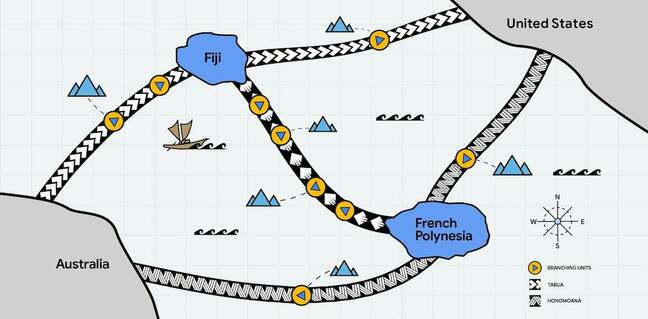US, Australia Solicit Google's Help With Pacific Subsea Cable Project
Google will build a pair of subsea cables connecting the US to Australia by way of Fiji and French Polynesia.
The project, announced Wednesday during a visit by Australian prime minister Anthony Albanese to the White House, will see Google work with local providers to bolster the resilience of subsea cables in a region prone to natural disasters and outages caused by shipping mishaps.
Cable breaks have been an ongoing problem, particularly in the Asia Pacific, so it's not hard to see why the US and Australia might want to add extra links that improve resilience.
According to Google, the cables will be laid in collaboration with Fiji International Telecommunications, the Office of Posts and Telecommunications of French Polynesia, AP Telecom, and Vocus Group. Australia will provide the bulk of the funding, fronting $50 million for the project, while the US has committed to $5 million in cash with provisions for another $10 million in the future.
The subsea cables will take two routes, called Tabua and Honomoana. The latter is named for the Polynesian words for "link" and "ocean" and will pass through French Polynesia. Tabua will connect Australia and the US with a stop in Fiji, with the island nation giving the link its name in reference to a sacred whale's tooth.

Google plans to build a pair of subsea ables connecting the US to Australia by way of Fiji and French Polynesia - Click to enlarge
Fiji and French Polynesia will also be connected by a third interlink cable. "This will serve to connect transpacific routes, improve reliability, add capacity, and reduce latency for users in the Pacific islands and around the world," Google said in a blog post.
The network will also include pre-positioned branching units. According to a White House fact sheet, these will provide an avenue to extend the network to the Federated States of Micronesia, Kiribati, the Marshall Islands, Nauru, Papua New Guinea, the Solomon Islands, Timor-Leste, Tuvalu, and Vanuatu.
Beyond the economic benefits inherent to improved connectivity, the project likely serves to prevent the spread of Chinese influence in the region.
As we've previously reported, China has extended offers to help South Pacific nations improve their network infrastructure using its homegrown technologies.
US aversion to Chinese communications equipment, not just in its own networks but that of its allies, is well established. After banning Huawei equipment from its own networks, the US has pressured others, including Australia, to do the same.
- Bermuda, your data, Google's gonna take your US data
- UK to crack down on imported Chinese optical fiber cables
- Pacific telco backed by Australia, Japan, US bins Huawei
- Five Eyes intel chiefs warn China's IP theft program now at 'unprecedented' levels
Details of the cables' capacity and speed have not been disclosed. The Register asked Google for more info, but the company was unable to provide those details or state when the cables will come online.
Based on the graphics shared in Google's blog post, we can at least estimate the Tabua and Honomoana cables will be somewhere in the neighborhood of 6,500 and 7,000 nautical miles — or 163,453 and 176,027 Devon fatbergs — as the crow flies.
Estimating the raw capacity of the cables is a little trickier, as it depends on the number of fiber strands, optics, repeaters, and amplifiers involved. For example, Google was able to hit 250Tb/s of capacity from 12 fiber pairs using space division multiplexing on its Duvant cable between Virginia Beach and the French Atlantic coast.
According to industry experts, substantially higher bandwidth could be achieved on future cables like Tabua, Honomoana, or Google's transatlantic Nuvem cable announced in September. As we previously reported, Nuvem could support between 400-480Tb/s using a 16 fiber pair cable and leading-edge optics. And that's using today's technology. By the time Tabua and Honomoana come online, we suspect they could be even more capable. ®
Google Leverages AI To Automatically Lock Phones During Theft
Amid increasing incidents of mobile phone thefts, Google has launched an AI-based feature that automatically locks the s... Read more
Microsofts Emissions Surge Nearly 30% Amid AI Demand Growth
Microsoft has reported a nearly 30% increase in its emissions from 2020 to 2023, underscoring the challenges the tech gi... Read more
Impact Of AWS Leadership Change On The Global AI Race
The recent leadership transition at Amazon Web Services (AWS), with Adam Selipsky stepping down and Matt Garman taking t... Read more
The Global Impact Of App Stores On Technology And Economy
Since Apple launched its App Store in 2008, app stores have become a central feature of the digital landscape, reshaping... Read more
Alibaba's Cloud Investment Strategy: Fuelling AI Innovation And Growth
Alibaba Group's cloud business, Alibaba Cloud, has emerged as a powerhouse in the tech industry, spearheading innovation... Read more
Elon Musk Takes On Government 'Censorship': A Clash Of Titans In The Digital Arena
Elon Musk's recent endeavors to challenge government-led content takedowns mark a significant development in the ongoing... Read more

